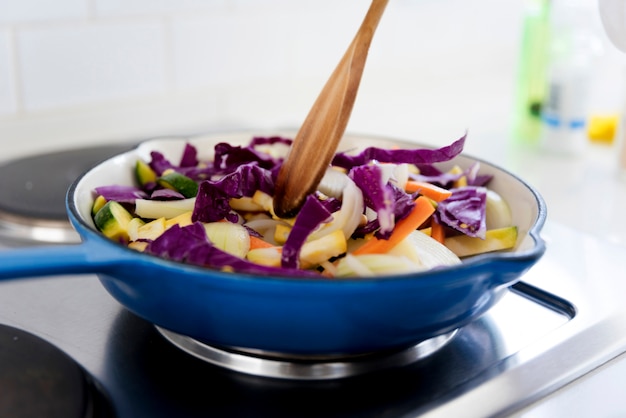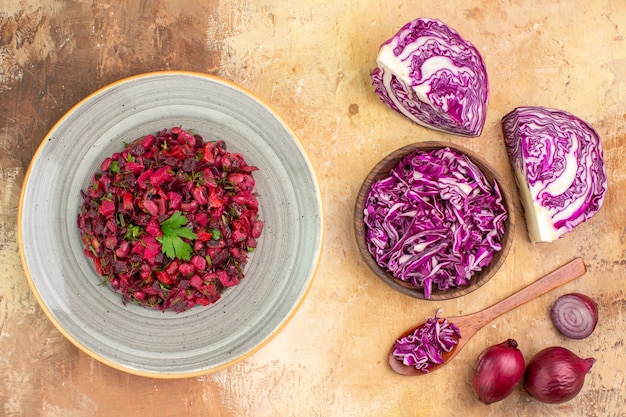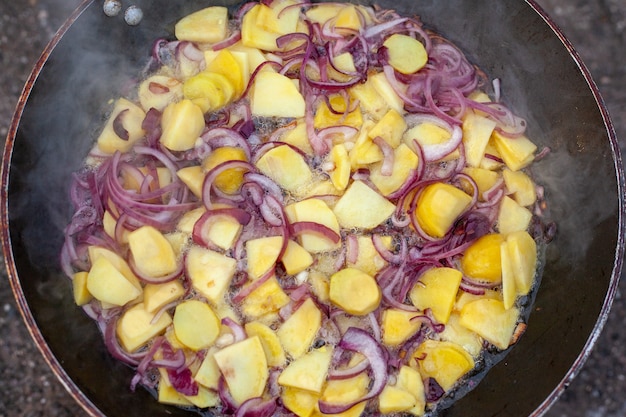There's something about corned beef and cabbage that just screams comfort food, right? It's a dish that brings back memories of childhood dinners, family gatherings, and even a touch of Irish heritage. But even with its simple ingredients, this classic dish can be daunting for some, leaving you wondering: what's the best cut of beef? How do you cook it without drying it out? And what exactly makes it a St. Patrick's Day staple? Well, fear not, my fellow food enthusiasts! This guide will be your compass through the world of corned beef and cabbage, helping you navigate the history, the techniques, and even some creative twists to make this meal a true masterpiece. Buckle up, it's about to get delicious!
(Part 1) A Journey Through Time: The History of Corned Beef and Cabbage

The story of corned beef and cabbage isn't just about a delicious meal; it's a story of migration, tradition, and resourcefulness. It all starts with the Irish. They relied heavily on salt to preserve meat, especially during long winters when fresh food was scarce. This technique, called "curing," gave birth to corned beef – a flavorful and long-lasting source of protein.
The Irish Connection: A Legacy in Every Bite
Cabbage, on the other hand, was a staple in their diet for a different reason – it was cheap, plentiful, and packed with nutrients. So, naturally, the two ingredients combined to create a hearty and satisfying dish. But the story doesn't end there. It's in the United States where corned beef and cabbage truly found its stardom.
When Irish immigrants began arriving in America during the 19th century, they brought their culinary traditions with them, including their love for corned beef. However, the American landscape offered a wider variety of options, and the typical corned beef was often out of reach for many immigrants. That's when they turned to a cheaper, readily available alternative – brisket. This tough but flavorful cut was then cured with salt and spices, creating a new kind of "corned beef." The rest, as they say, is history – a delicious history!
A Dish for Every Season: A Comfort Beyond Time
While corned beef and cabbage is often associated with St. Patrick's Day, it's a dish that transcends the calendar. It's a warm and comforting meal perfect for chilly evenings, and even a light and refreshing dinner option when paired with a crisp salad during warmer months. It's a versatile dish that fits seamlessly into any season, proving its enduring appeal.
(Part 2) Choosing the Right Ingredients: A Cornerstone of Greatness

Now, let's talk ingredients. This is where your journey to deliciousness really begins. Just like any good chef, you need to start with quality ingredients, and this dish is no exception. So, let's dive into the specifics!
The Beef: Finding the Perfect Cut
The hero of our dish is the corned beef – a beautifully cured brisket. Now, not all briskets are created equal, so choose wisely! Look for a brisket that's got a nice layer of fat, often called a "fat cap." This fat will melt down during cooking, adding incredible moisture and flavor to the meat. You want a brisket with a deep red color, as pale or grayish tones might indicate an older or less fresh cut.
Cabbage: Fresh and Crisp for the Perfect Bite
Next, we have the cabbage. You want a head that's firm, heavy, and has crisp, green leaves. Avoid any that are soft, wilted, or have yellowing leaves. A good rule of thumb is to choose a cabbage that's about the same size as your brisket, ensuring you have enough for a satisfyingly hearty dish!
Spice It Up: Don’t Forget the Seasonings
The corned beef itself is usually brined in a blend of spices, often salt, pepper, coriander, and bay leaves. This gives it a savory depth of flavor that's truly irresistible. But don't be afraid to experiment! I love adding a few juniper berries or a touch of clove for a subtle twist. You can even use different spice blends, or create your own custom mix for a truly unique flavor profile.
And remember, the seasonings don't stop there. You can add other vegetables to your pot for a complete and flavorful meal. Carrots, potatoes, and even onions add a welcome dimension. Experiment and find what suits your taste!
(Part 3) The Art of Cooking: Mastering the Technique

Now comes the fun part – turning those ingredients into a delicious masterpiece! cooking corned beef and cabbage isn't rocket science, but it does require a little patience and finesse. So, gather your pot, your trusty wooden spoon, and let's get cooking!
The Slow and Steady Approach: Patience is Key
The secret to a perfectly tender and flavorful corned beef lies in slow cooking. This low and slow method allows the meat to break down, becoming incredibly tender and absorbing all those delicious flavors. You can cook it in a large pot on the stovetop or in a slow cooker. I prefer the stovetop method for greater control over the heat and cooking time.
The Steps to Success: A Symphony of Flavors
Here's the basic breakdown:
- Rinse the corned beef and remove any excess spices.
- Place it in a large pot and cover it with cold water.
- Bring the pot to a boil, then reduce the heat to a simmer.
- Simmer for 2-3 hours, or until the meat is tender enough to shred easily with a fork.
- While the corned beef simmers, prepare your cabbage. You can cook it alongside the beef or separately. I prefer to cook it separately to preserve its beautiful green color.
- Slice the cabbage into wedges or quarters and place it in a pot with a little water or broth.
- Simmer the cabbage for about 10-15 minutes, or until tender, but still with a bit of bite.
- Once the corned beef and cabbage are cooked, it's time to assemble your masterpiece! You can serve the corned beef sliced, shredded, or chopped. I love to shred it, as it's easier to eat and allows the meat to absorb all those delicious juices.
- Don't forget the broth! This is the secret ingredient. This flavorful broth can be used to make a delicious gravy or simply laded over your corned beef and cabbage for extra richness.
The Importance of Patience: A Delicious Reward
I know the aroma of that simmering corned beef will make you want to dig in immediately, but patience is key. Let the meat cook slowly and don't rush the process. The results will be worth the wait, I promise!
(Part 4) Beyond the Basics: Elevate Your Corned Beef and Cabbage Game
Alright, so you've mastered the basics – but what if you want to take your corned beef and cabbage from good to amazing? We're about to explore some creative twists and flavorful additions to elevate this classic dish to new heights.
Go for the Bold: Adding Flavour
While the traditional spice blend is fantastic, you can always add a little something extra. A couple of slices of lemon in the pot will brighten the broth's flavor, adding a refreshing touch. Or, for a more herbaceous note, try adding a few sprigs of fresh dill. The possibilities are endless, and experimenting with different flavors is part of the fun!
The Power of Sides: Elevate Your Plate
Don't underestimate the power of sides! Classic choices like mashed potatoes, boiled carrots, or even a simple side salad can enhance your corned beef and cabbage. But for a truly special meal, consider adding a side with a little twist. A creamy coleslaw with a touch of sweetness or a tangy sauerkraut can balance the richness of the dish.
A Touch of Tradition: Irish Soda Bread
If you want to embrace the true Irish spirit of this meal, serve it with a slice of Irish soda bread. This simple yet delicious bread is the perfect accompaniment to the rich flavors of the corned beef and cabbage. It's incredibly easy to make – just find a good recipe and get baking!
(Part 5) Serving Up a Feast: Presenting Your Culinary Creation
You've cooked a masterpiece, now it's time to present it with style! Let's talk about how to serve your corned beef and cabbage so it looks as good as it tastes, impressing your guests and creating a memorable meal.
The Presentation Matters: Make It Look Lovely
Just because it's a simple dish doesn't mean you can't present it beautifully! Don't just slap it on a plate and call it a day. Take some time to arrange it neatly. Even a simple serving of corned beef and cabbage can be elegant with a bit of creativity.
A Touch of Colour: Use Herbs and Garnishes
I always add a pop of color to my corned beef and cabbage. A sprig of fresh parsley or a few dill sprigs on top of the plate add a touch of green and fresh flavor. And don't forget a dollop of mustard or horseradish for a tangy kick!
The Importance of Comfort: Create a Warm and Inviting Ambiance
A great meal is about more than just the food; it's about the atmosphere. Set the scene for your corned beef and cabbage dinner. Light some candles, put on some music, and gather your loved ones around the table. Create a warm and inviting atmosphere, and your meal will taste even better.
(Part 6) Beyond the Plate: Leftover Magic
Okay, let's be honest – corned beef and cabbage is even better the next day. But sometimes you just want to try something new! Don't worry, your leftovers can become the star of a new culinary adventure.
The Leftover Symphony: Turning Scraps into Delights
You can always reheat the corned beef and cabbage, but if you're feeling adventurous, get creative! leftover corned beef can be transformed into a delicious hash, a hearty soup, or even a cheesy casserole. Use leftover cabbage to make a quick slaw or a simple stir-fry.
The Broth is the Secret Weapon
Don't throw away that broth! It's a flavor bomb waiting to be unleashed. Use it to make a delicious gravy, add it to your next soup or stew, or even freeze it for later use. It's packed with flavor and will add a touch of corned beef magic to any dish.
(Part 7) FAQs: The Answers You Need
I know you've got questions! So, I put together this FAQ section to address some of the most common concerns about corned beef and cabbage.
How Long Does It Take to cook corned Beef and Cabbage?
Cooking time for corned beef depends on the size and thickness of the brisket. Generally, it takes about 2-3 hours to cook corned beef until it's tender. Cabbage takes about 10-15 minutes to cook, but you can also cook it alongside the corned beef for a longer time to soften it further.
What Should I Serve with Corned Beef and Cabbage?
Corned beef and cabbage goes well with a variety of sides. Classic choices include mashed potatoes, boiled carrots, and Irish soda bread. For a twist, try a creamy coleslaw or a tangy sauerkraut.
How Do I Reheat Corned Beef and Cabbage?
You can reheat corned beef and cabbage in the oven, on the stovetop, or in the microwave. For the oven, preheat to 350 degrees fahrenheit (175 degrees Celsius) and heat the corned beef and cabbage in a baking dish for about 20 minutes. For the stovetop, heat the corned beef and cabbage in a pot over low heat, stirring occasionally, until heated through. For the microwave, heat the corned beef and cabbage in a microwave-safe dish on high for 1-2 minutes, or until heated through.
Can I Make Corned Beef and Cabbage in a Slow Cooker?
Absolutely! A slow cooker is a fantastic way to cook corned beef and cabbage. Simply place the corned beef in the slow cooker, cover it with water, and cook on low for 8-10 hours, or on high for 4-6 hours. Add the cabbage to the slow cooker during the last hour of cooking.
What Are Some Healthy Substitutes for Corned Beef and Cabbage?
If you're looking for a healthier alternative, you can substitute the corned beef with leaner cuts of beef, like flank steak or sirloin tip. You can also use chicken or turkey for a lighter option. As for the cabbage, you can use other leafy greens, like kale or collard greens.
(Part 8) A Final Word
So there you have it, folks! You're now equipped with the knowledge to conquer the world of corned beef and cabbage. Remember, this dish is about tradition, comfort, and good company. Gather your ingredients, bring your loved ones together, and get cooking!
I hope this guide has been helpful. Now go forth and create culinary masterpieces!
Everyone is watching

Corn on the Cob: The Ultimate Guide to Perfectly Cooked Ears
Healthy MealsAh, corn on the cob. Just the name evokes images of sunny days, barbecues, and that sweet, juicy flavour that ...

Scallops: The Ultimate Guide to Perfect Cooking
Healthy MealsAh, scallops. Those delicate, sweet, and utterly delicious morsels of the sea. They hold a special place in my...

Spaghetti Squash: The Ultimate Guide to Cooking and Serving
Healthy MealsRemember that time you saw spaghetti squash at the supermarket, looking all bumpy and strange, and thought, "W...

Salmon Cooking Times: Perfect Guide for Every Recipe
Healthy MealsLet me tell you, cooking salmon is an art form. It's all about getting that perfect balance: juicy and tender,...

Ham Cooking Time: How Long to Bake, Smoke, or Boil a Delicious Ham
Healthy MealsAh, ham. It's a classic, isn't it? A real crowd-pleaser, especially around holidays. And when done right, it'...
